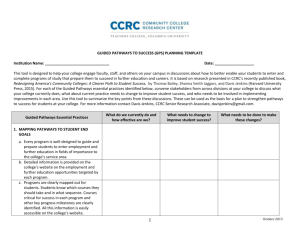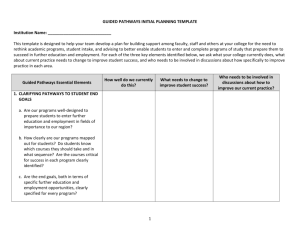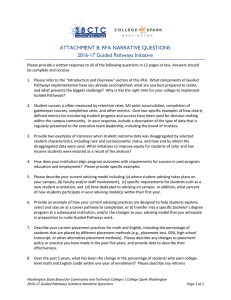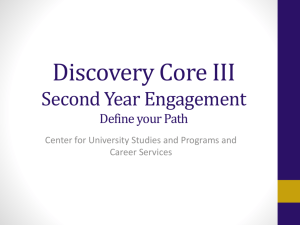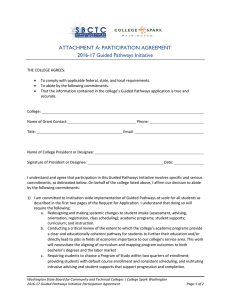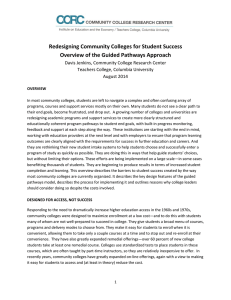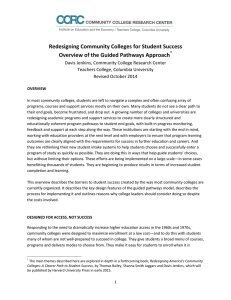Some key ideas from literature related to creating Advising Pathways
advertisement
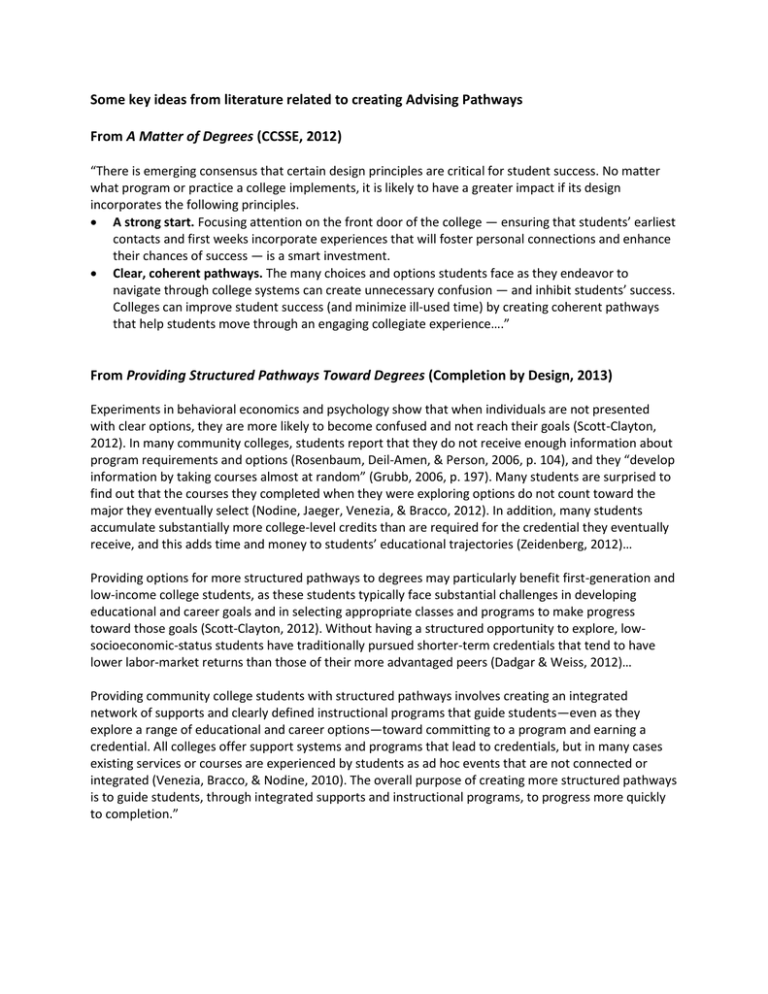
Some key ideas from literature related to creating Advising Pathways From A Matter of Degrees (CCSSE, 2012) “There is emerging consensus that certain design principles are critical for student success. No matter what program or practice a college implements, it is likely to have a greater impact if its design incorporates the following principles. A strong start. Focusing attention on the front door of the college — ensuring that students’ earliest contacts and first weeks incorporate experiences that will foster personal connections and enhance their chances of success — is a smart investment. Clear, coherent pathways. The many choices and options students face as they endeavor to navigate through college systems can create unnecessary confusion — and inhibit students’ success. Colleges can improve student success (and minimize ill-used time) by creating coherent pathways that help students move through an engaging collegiate experience….” From Providing Structured Pathways Toward Degrees (Completion by Design, 2013) Experiments in behavioral economics and psychology show that when individuals are not presented with clear options, they are more likely to become confused and not reach their goals (Scott-Clayton, 2012). In many community colleges, students report that they do not receive enough information about program requirements and options (Rosenbaum, Deil-Amen, & Person, 2006, p. 104), and they “develop information by taking courses almost at random” (Grubb, 2006, p. 197). Many students are surprised to find out that the courses they completed when they were exploring options do not count toward the major they eventually select (Nodine, Jaeger, Venezia, & Bracco, 2012). In addition, many students accumulate substantially more college-level credits than are required for the credential they eventually receive, and this adds time and money to students’ educational trajectories (Zeidenberg, 2012)… Providing options for more structured pathways to degrees may particularly benefit first-generation and low-income college students, as these students typically face substantial challenges in developing educational and career goals and in selecting appropriate classes and programs to make progress toward those goals (Scott-Clayton, 2012). Without having a structured opportunity to explore, lowsocioeconomic-status students have traditionally pursued shorter-term credentials that tend to have lower labor-market returns than those of their more advantaged peers (Dadgar & Weiss, 2012)… Providing community college students with structured pathways involves creating an integrated network of supports and clearly defined instructional programs that guide students—even as they explore a range of educational and career options—toward committing to a program and earning a credential. All colleges offer support systems and programs that lead to credentials, but in many cases existing services or courses are experienced by students as ad hoc events that are not connected or integrated (Venezia, Bracco, & Nodine, 2010). The overall purpose of creating more structured pathways is to guide students, through integrated supports and instructional programs, to progress more quickly to completion.” From Get with the Program: Accelerating Community College Students’ Entry into and Completion of Programs of Study (Davis Jenkins and Sung-Woo Cho to be published in New Directions Journal, 2013) “Community colleges are also beginning to implement the guided pathways approach... Evidence for this approach comes from research on a variety of fronts. Studies of student pathways show the chaotic enrollment patterns and poor outcomes for students who self-advise (Crosta, 2013). Moreover, community college students often indicate through surveys and focus groups that they are very confused about what path to take and want clearer guidance (Venezia, Bracco, & Nodine, 2010). Research on K-12 education finds that schools that are able to achieve greater gains in student outcomes, and particularly with students from disadvantaged backgrounds, are characterized by higher levels of “instructional program coherence.” This is defined as: “a set of interrelated programs for students and staff that are guided by a common framework for curriculum, instruction, assessment, and learning climate, and that are pursued over a sustained period of time” (Newmann et al., 2001, p. 299; see also Bryk et al., 2010). Although there has been no comparable research in higher education, there is no reason to believe that the same would not apply to broad-access institutions… Implementing guided pathways requires that colleges rethink how they organize programs and services at scale. Managing a wholesale organizational redesign process such as this is challenging in any environment, but it is especially so in times of scarce resources. Research on organizational effectiveness and improvement in higher education and other sectors highlights the importance of a set of management practices for supporting and sustaining organizational innovation (Jenkins, 2011)… Strong, outcomes-oriented leadership… Broad-based engagement and supporting professional development... Evidence-based improvement... Attention to cost-effectiveness and productivity. ..” From the Loss Momentum Framework (AACU, 2012) A momentum strategy is “ Mandatory “intrusive” advising,.., life skills courses… declared courses of study linked career pathways.” From Core Principles for Transforming Remedial Education: A Joint Statement (Charles A. Dana, Jobs for the Future, 2012): “Seven Core Principles. 1. Completion of a set of gateway courses for a program of study is a critical measure of success toward college completion… 2. The content of required gateway courses should align with a student’s academic program of study — particularly in math… 3. Enrollment in a gateway college-level course should be the default placement for many more students… 4. Additional academic support should be integrated with gateway college-level course content — as a co-requisite, not a prerequisite… 5. Students who are significantly underprepared for college-level academic work need accelerated routes into programs of study.. 6. Multiple measures should be used to provide guidance in the placement of students in gateway courses and programs of study… 7. Students should enter a meta-major when they enroll in college and start a program of study in their first year in order to maximize their prospects of earning a college credential…” From Complete College GPS: Guided Pathways to Success (Davis Jenkins meeting notes, 2012) During a meeting at the City College of Chicago on August 29, 2012, three presenters went over research from psychology, guided programs of study, and community colleges. There were presentations on and discussion about three models of guided pathway advising: Arizona State University’s eAdvisor, Austin Pey University’s Degree Compass, and Florida State University’s effective mapping with intrusive advising. The group made four policy recommendations: Mapping can be scaled for every program for both community colleges and university degrees in a state. Strongly encourage student to select an “area of interest.” Improvements in retention and graduation should be part of institutional funding. Funding bonuses for graduating Pell students.”
